I have been somewhat time strapped in the summer of 2016, with a (temporary) full time job in Hoboken that demands 9 or 10 hours daily, a desire to relax the remaining two hours or so each day, and then plan and execute tours on the weekends. Thus, I’m sure you’ll forgive me if I reprise a post I did when I was working for Brownstoner Queens (the site has since been folded into its Brooklyn progenitor) a year or so ago in Woodside, which I have expanded a bit with photographs from a ramble en route to another obligation; it also incorporates part of the Forgotten New York book, available at Amazon and other venues (has it been ten years since its release?). I wouldn’t mind if the temp job became permanent. Cue Richard Kiley or Jack Jones singing “The Impossible Dream.”
What would become Woodside, a bustling community centered at Roosevelt Avenue and 61st Street where the #7 Flushing Line and the Long Island Rail Road come together, was originally a part of a larger colonial village, Newtown. It was largely a woodsy swamp until the mid-1860s, when developer Benjamin Hitchcock purchased the John Kelly farm and divided it into building lots located along today’s Woodside Avenue. Kelly, an early settler, was part owner of a Brooklyn newspaper and sent it dispatches from his home in the ‘sticks’ called “Letters from Woodside;” Hitchcock perpetuated the name. Woodside took off when the Queensboro Bridge opened in 1909 and the el arrived in 1917. Woodside’s strange street pattern, with some streets angling for seemingly no reason, has to do with its old railroads: the Flushing and Woodside and Flushing and Northside Railroads, as well as the Long Island Rail Road, all ran through Woodside. By the late 19th century, the railroads had either failed or had been absorbed by the LIRR. The surviving roads, absorbed into the LIRR, were elevated by 1917.
Today in Woodside you are just as likely to exit an Irish bar and enter an Indian restaurant as you are to walk out of a bodega and then past a remnant of the colonial era. Woodside has succeeded in hiding in plain sight some of its more prominent relics from the old days, too.
In the title card: at the corner of 58th Street and 39th Avenue, beside the railroad overpass west of the LIRR Woodside station, is a shambling, two-story residence that gives just a little hint of past grandeur. For several decades, this was a hotel that sat beside the railroad tracks, which were at grade when the house was built in 1882.
The hotel was constructed by German immigrant John Meyer, who arrived in Queens in 1877. He gained employment as a bartender/manager at a local watering hole called the Woodside Pavilion, which still stands as an unprepossessing private dwelling with white aluminum siding and brown window shutters, a block away at 39th and 57th. Meyer intended to become a saloon owner/hotelier himself and had Meyer’s Hotel constructed for $10,000 in 1882, with then-modern amenities private baths, running hot and cold water, modern kitchen, barber shop, and a livery service. Much of the cost went into sumptuous appointments such as yellow hardwood pine floors, black walnut moldings and paintings by renowned local artists.
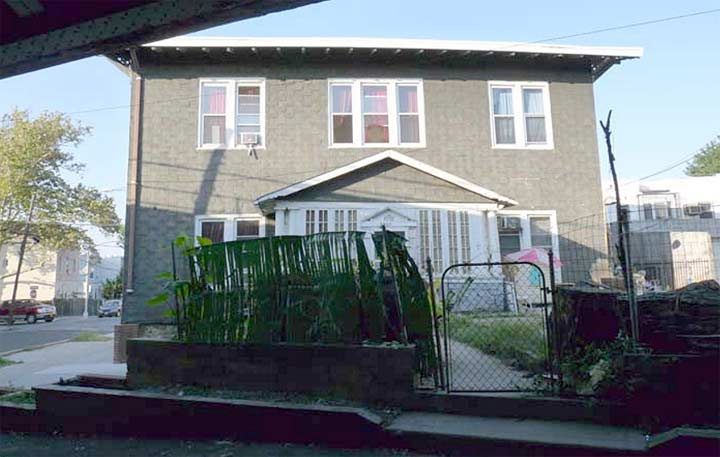
Meyer was not around long to savor the hotel’s success, as he perished from a heart attack in 1887. His widow Katherine remarried, to George Shreiner, and kept the business going as the Katherine Meyer Hotel, which was later taken over by John E.A. Meyer, John and Katherine’s son.
As the decades went by Woodside was losing its rural aspect. The city was coming to Queens, and the Long Island Rail Road decided to eliminate its grade crossing and add extra tracks to its main branch, which wound up passing in front of Meyer’s Hotel. A massive elevated trestle was built right over the building’s front gate. John E. A. Meyer closed his father’s old hotel in 1917, the year after the trestle opened, and it became a two-family house. It’s likely that the current residents have no idea the place used to be one of the jewels of Woodside hospitality.
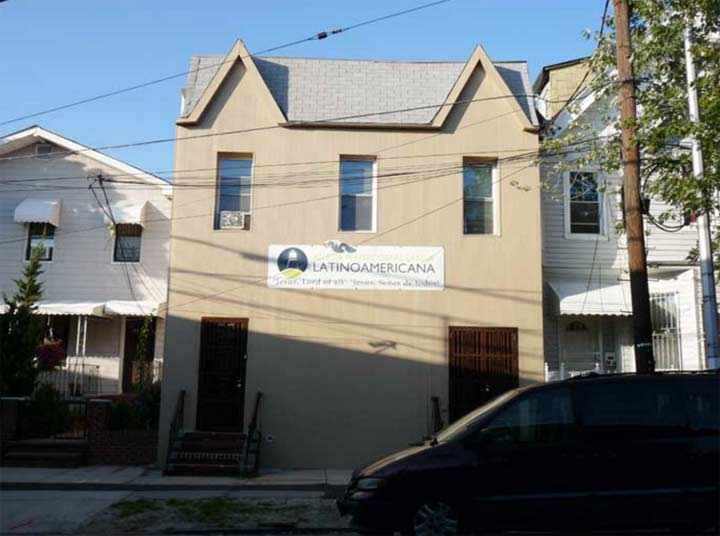
Right next door to the old Meyer’s Hotel building on 39th Avenue is the former home of the Woodside Hook and Ladder Company. The fire brigade, formed in May 1878 as Newtown Fire Department Company #3, originally built a firehouse on Woodside Avenue and 60th Street, but outgrew what was a small building and raised the money to build a new firehouse on Riker Avenue, now 39th. The new firehouse was dedicated on November 17, 1884. The building came to be known as the Truck House or Firemen’s Hall, and it became a community center of sorts next to the then-handsome Meyer’s Hotel, hosting community fundraisers and socials.
As early as 1895 Lutheran services were held in the building. The fire company was disbanded in 1913 and the Truck House has had many diverse uses since then, serving as a post office, and American Legion Hall, and currently, a nondenominational church serving local Spanish speakers. All trace of the building’s former use as a firehouse and firemen’s hall has vanished.
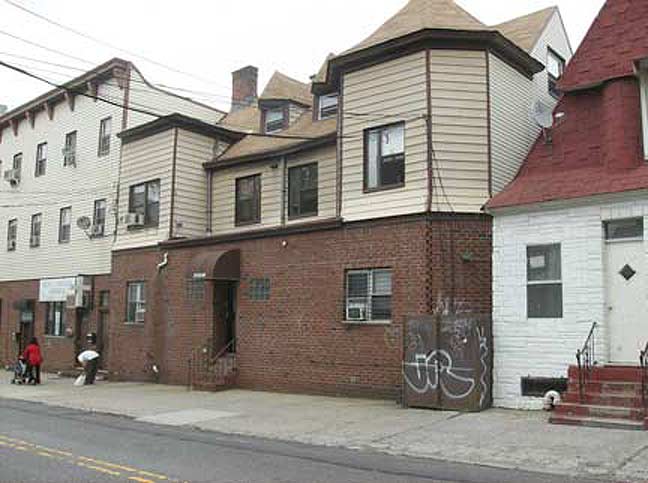
Other than the grocery on the corner of 38th Avenue and 58th Street, the stretch of 58th Street between 37th and 38th Avenues is unrecognizable as the commercial strip it used to be. The east side is lined with tile and marble wholesalers, electrical contractors and other service enterprises. As you get toward 38th Avenue, though, there are several low-rise buildings of considerable age that are hidden behind layers of aluminum siding. Many of the buildings go back to Woodside’s first phase of development in the mid-to-late 1800s.
This building at 37-53 58th Street is one such building, and you can tell that it used to be somewhat grander in aspect. There are two turrets, one flat on top and one with a conical peak, and a couple of dormers on top. “Good bones” as housing advocates put it.
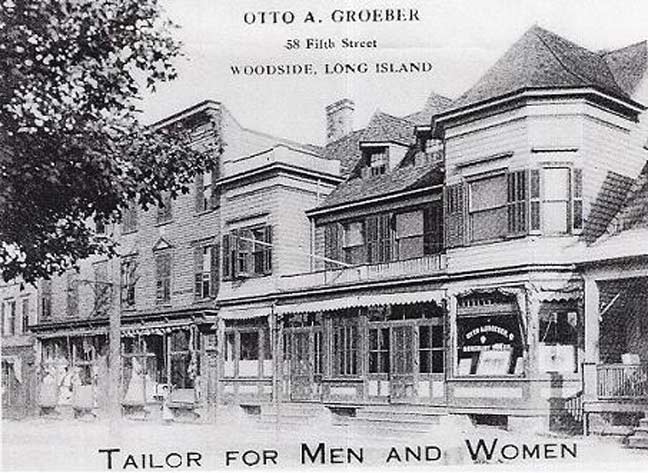
When first built, it had a tailor shop on the street and residences upstairs. The tailor shop was owned by Prussian immigrant Otto Groeber at #58 5th Street, which during the 1920s acquired its current address. Groeber also purchased property around the corner on 38th Avenue; he operated the tailor shop with his family until his retirement in 1918 at age 91.
On the left was a meat market called Stern’s and a dry goods shop (today’s five and ten). A pharmacy was to the right of the tailor; Groeber’s name is inscribed on the picture window.
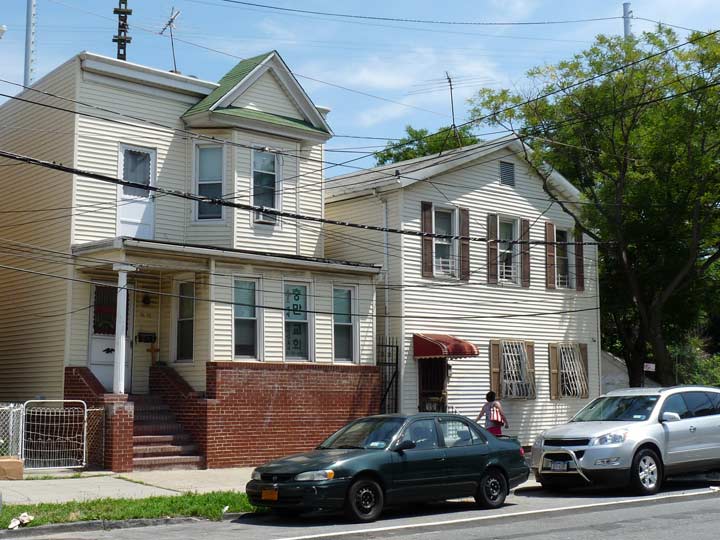
Heading back to 39th Avenue, at the corner of 57th Street there’s a small two-story residence (right) that gives no hint to its former role as a town gathering place.
In the 1880s the house was known as Berry’s Hotel; Jake Berry was the former owner of Manhattan’s Columbia Opera House, and staked out some territory in what was then an up and coming area in Queens.
An ad in the Newtown Register for May 1, 1882, Berry advertised it for lease:
Berry’s Hotel, Woodside, Long Island, Queens County, being the only first-class house in the place; the Hotel is situated on the best corner, near the depot, on Riker Avenue; it is the only Hotel that has fruit and shade trees. Or will let the whole square, and will make the place into a park or grove, and build, if desired, a theatre, ballroom, ten-pin alley, billiard-hall, and shooting gallery. Or will let it for hardware, dry goods, grocery, or liquor store. None but responsible parties need apply…
J.S. Berry
122 South Second street, Wiliamsburgh
Berry operated it as a hotel until 1900, whereupon it spent several years in mixed use; St. Sebastian’s Church (now at Roosevelt Avenue and 58th Street) used it as a band practice hall, and the local Democratic club hosted events there. Eventually it was converted to residential use and the present siding was added, masking its old use as a community center.
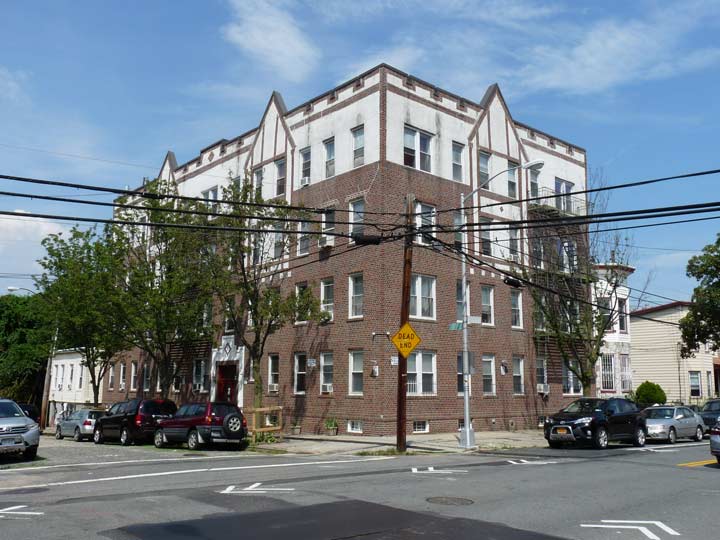
When I was first looking for a place in Queens, I checked out an apartment in this building at 39th Avenue and 57th Street. This was in 1993, and I don’t remember anything at all about the apartment I was shown; it must now be several hundred dollars more in rent than when I was thinking about it.
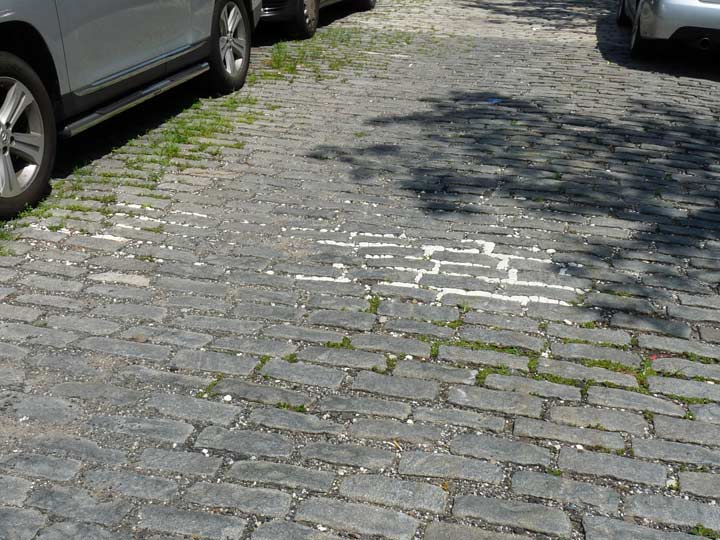
But it would have been cool (to me) to live on a dead end street that a) ended at a railroad and b) still had its ancient Belgian block paving, the only remaining street in Woodside with it.

Many homes in Woodside no doubt have rich histories that have gone unrecorded. This small house sits just to the east of the corner apartment house and is considerably set back from the street, giving it an expansive front yard. Its roof corbelling marks it as being of considerable age.

This small stone house on 56th Street south of 39th Avenue differs from its neighbors as having no frontage at all. The entrance is up a short flight of steps on its right side.
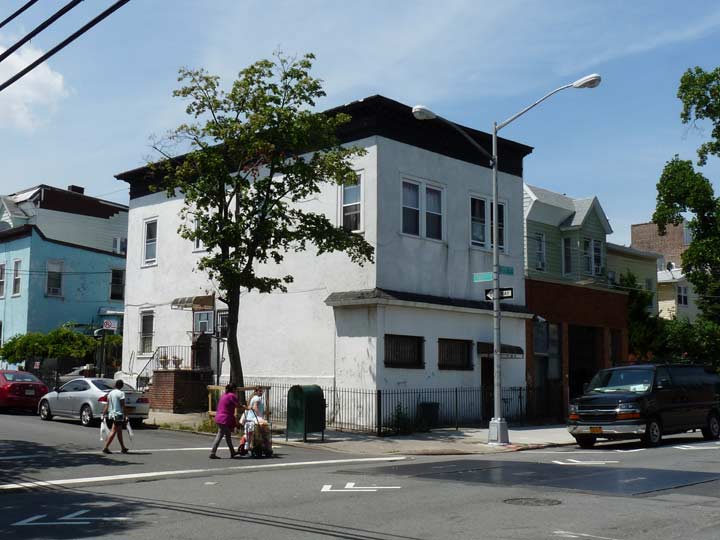
The same developer may have built this boxy stone residence on the corner of 39th and 56th.
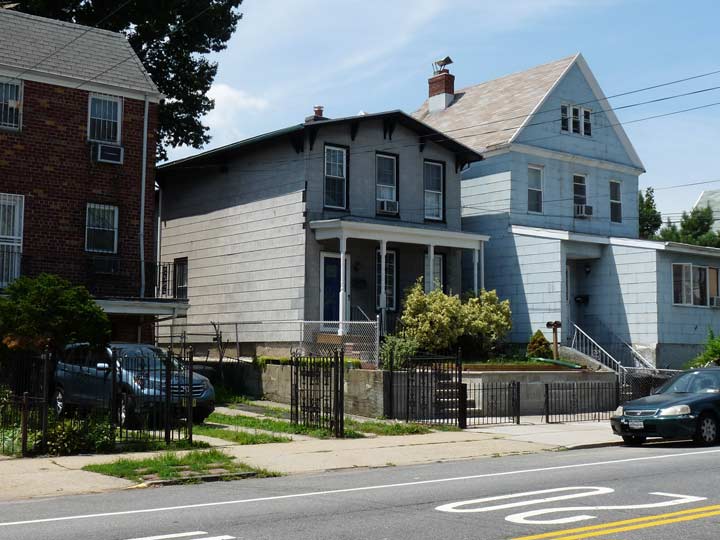
There are a lot of historical gems hidden in Woodside, some of them hidden behind layers of modern aluminum siding — but some of them look pretty much the same as when they were built.
This two-story peaked-roof house was constructed at 54-04 39th Avenue in about 1872, when the road was still known as Riker Avenue. Warren H. Lamson purchased the property from John A. Kelly’s heirs in 1871 (Kelly, a local journalist, farmed in Woodside in its early days and published articles under the banner “Letters from Woodside”; the neighborhood was still heavily wooded in the mid-1800s).
Lamson, born in Boston, became the first teacher in Woodside’s first public school and also taught classes in his home on Riker Avenue.
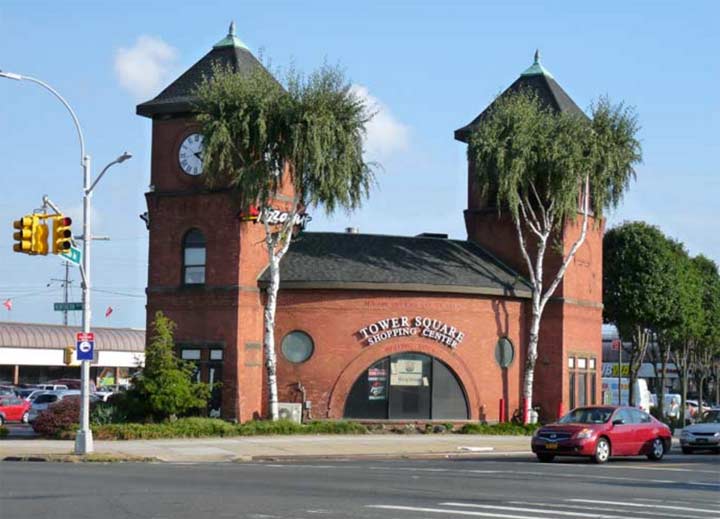
There are other relics in Woodside, but none quite as obvious as the former trolley barn belonging to the New York and Queens Railway Company at the pivotal intersection of Northern Boulevard and Woodside Avenue, the border of Woodside and Long Island City.
William Steinway, the scion of the great piano manufacturing family, electrified his Long Island City streetcar line, the Steinway Railway Company, and hooked up with developer Cord Meyer’s Newtown Railway Company, which extended to Corona, in 1894. Two years later, the lines reorganized as The New York and Queens County Railway Company and built a handsome, twin-spired brick depot at Northern Boulevard and Woodside Avenues. Trolleys would ply these roads to Queens’ eastern sections. Steinway had tried to extend his trolley line to Manhattan via two tunnels under the East River in 1892, but financial and engineering problems stymied the project. Steinway’s friend, banking tycoon August Belmont, completed the tunnels in 1907, but they were not to gain regular use until 1915, when the Interborough Rapid Transit modified them for subway use. The IRT built the Flushing Line in increments, finally reaching Main Street in Flushing by 1928.
Meanwhile, trolley service out of the New York and Queens County Railway depot continued until September 1937, when buses took over. The eastern end of the building was torn down in 1930 after a fire. Over the decades, the old trolley barn was deserted and was in danger of demolition until it was preserved in 1987 as part of the Tower Square Shopping Center. The north tower’s clock again works, and the arched entrance you can still find “N.Y. and Queens County Ry. Company” and “Waiting Room ” emblazoned. A short walk down Woodside Avenue under the Amtrak tracks at 37th Avenue will bring you to a corner laundromat; walk around the corner to find yet another “New York and Queens County Ry. Company” carving.
This is a special location as far as FNY is concerned — it was the subject of the first page I wrote for teh website in late 1998.
Source: Woodside: A Historical Perspective 1652-1994 by Catherine Gregory. It’s an unvaluable resource for Woodside history — a bit hard to find these days, though.
7/24/16


2 comments
I remember taking oil painting lessons on Saturday mornings from a woman in the old Meyer Hotel back around 1974-75.
Thank you for this story!!
There was an old post office on 60th street, at the end near the LIRR tracks. It was a brick building across from the large apartment bldg at 3950 60th Street. My mother grew up there in the 1930s and 40s, and recalled that the apartment building received the mail before anyone else. looking on Google Street Images, it seems that the building is gone.